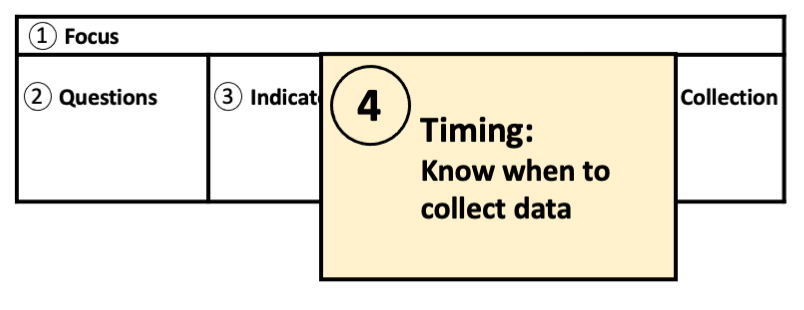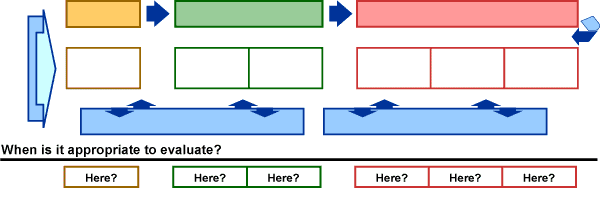Home » Enhancing Program Performance with Logic Models » Section 7: Using Logic Models in Evaluation » 7.14: Timing
7.14: Timing

Scheduling Data Collection
Another benefit of using a logic model to help with evaluation is in identifying WHEN it is appropriate to collect data.
Look at your logic model and your evaluation questions, and see WHEN along the pathway you will want to collect data–when the program can be expected to be at the stage to make the desired data collection possible and meaningful. Problems in the past with asking questions and collecting data when programs were not ready led to evaluability assessment and was a precursor to logic models. For example, evaluation information about who is participating should be collected at each session, while data to answer questions about behavior change would have to be collected at some point after completion of the program.

Data collection can occur at several possible points in time:
- Baseline
- Beginning of program–specific event/activity
- During implementation
- End of program–end of specific event/activity
- Monthly, quarterly, annually
- Follow-up: when?
Learn More Baseline Data
What data do you need and/or want to collect BEFORE the program starts? By thinking about evaluation upfront in the program development process and by using a logic model, you will be able to identify data you need to collect for comparison purposes. Any evaluation question that expresses an increase, reduction, or other type of change requires a basis for comparison. Such information can be collected retrospectively, but usually is more accurate and credible if collected as baseline.
We use the terms markers, milestones, benchmarks interchangeably to refer to those points along the pathway of change–your logic model–at which you want and need to collect data to show progress, capture significant process achievements, or lay a “stake in the sand” for making comparisons and documenting trends. Consider whether there will be any critical events on the occurrence of which you should collect data.
By looking at the total logic model, you can determine WHEN to collect what data to demonstrate progress and to have information available for program improvement and modifications.




